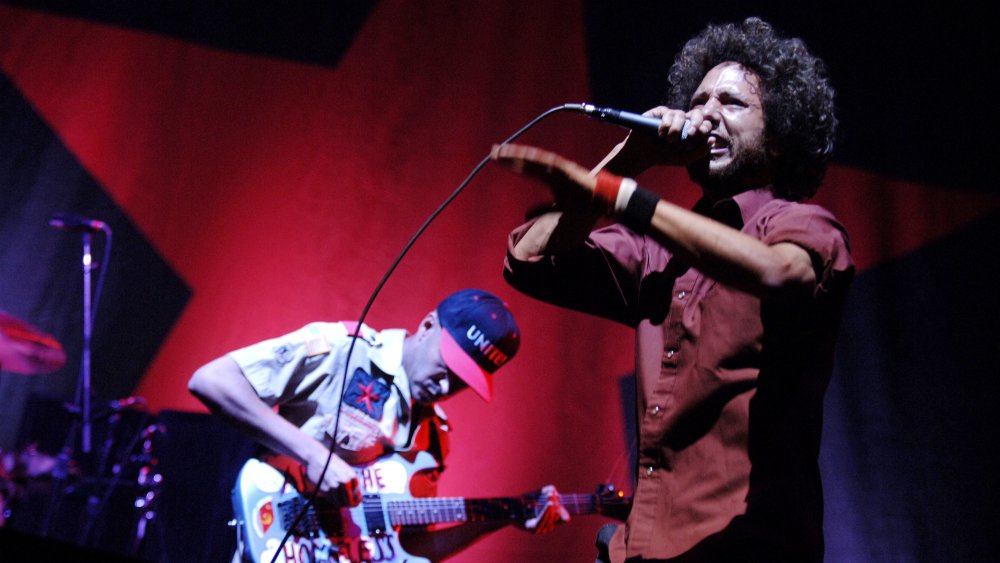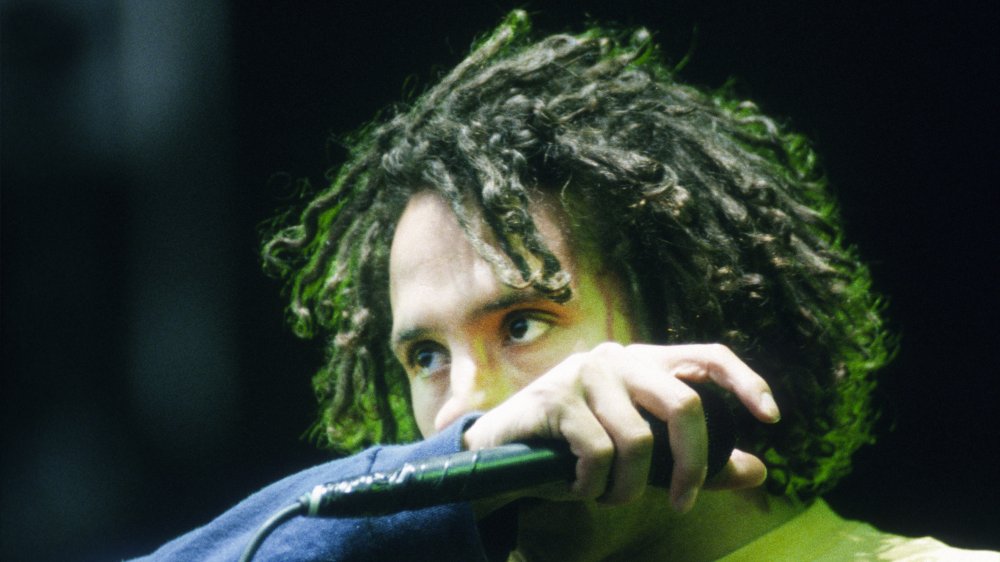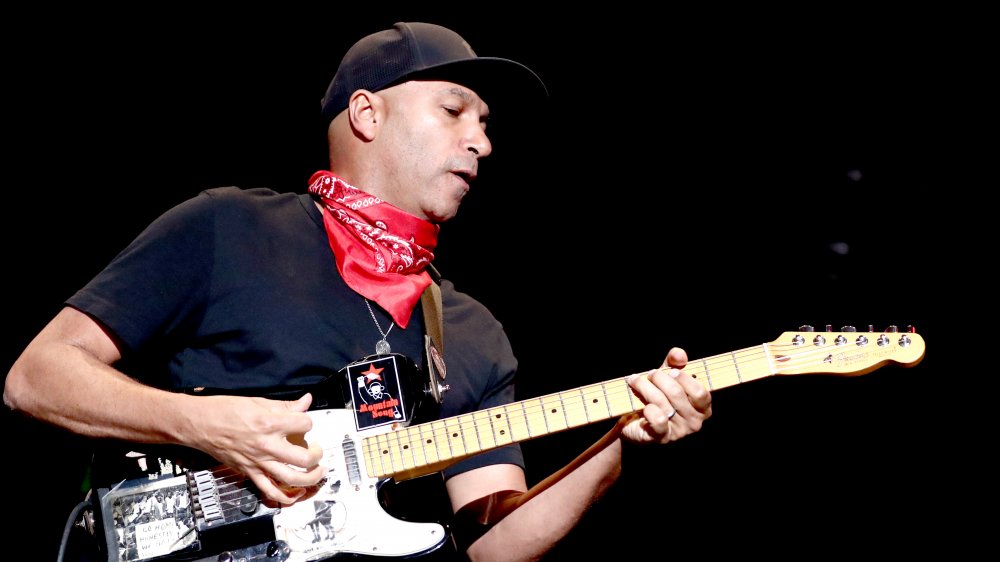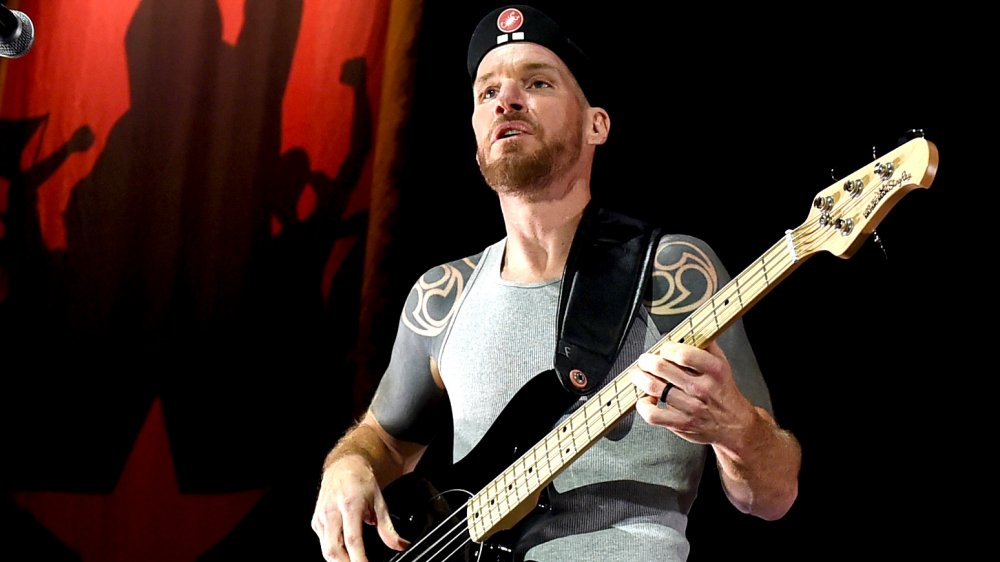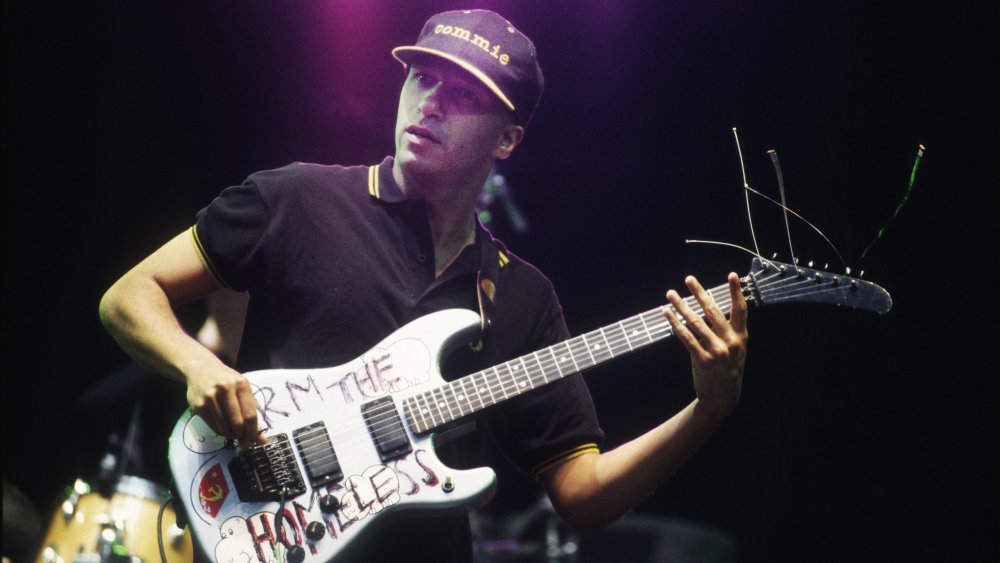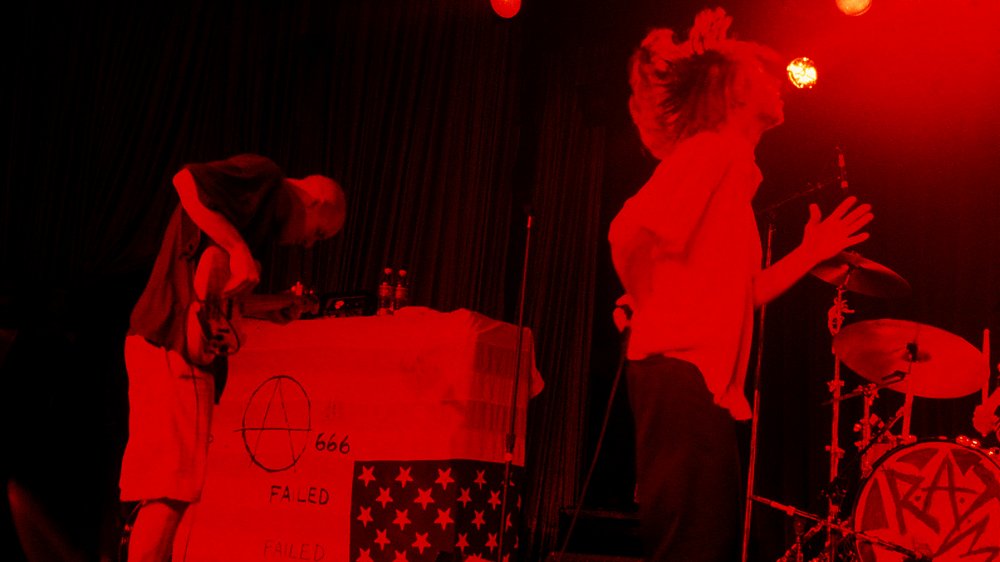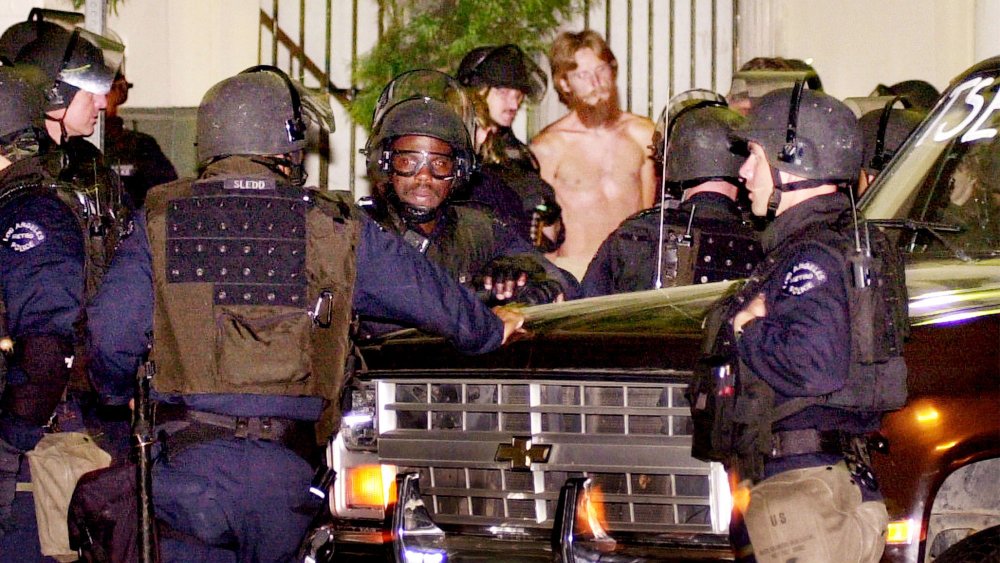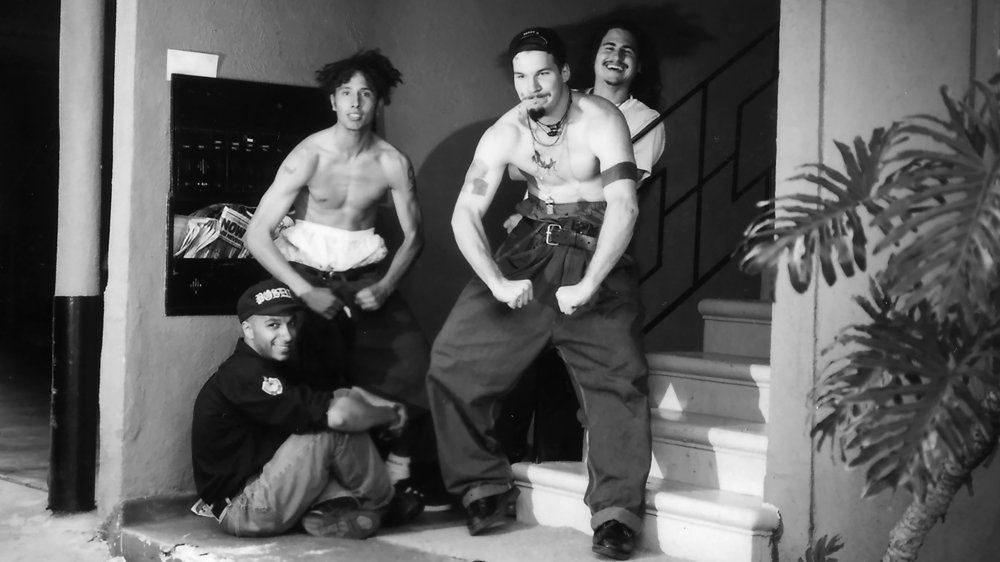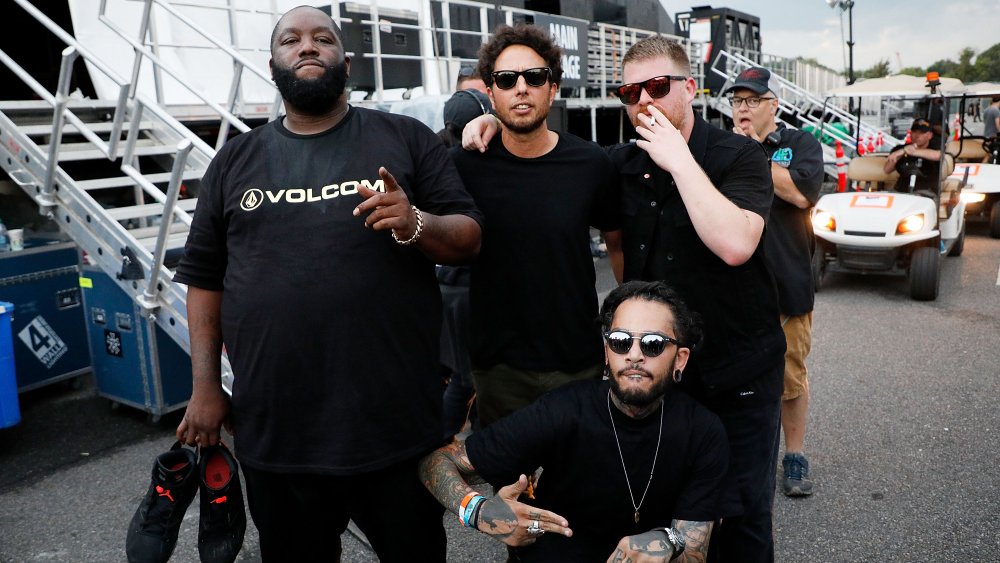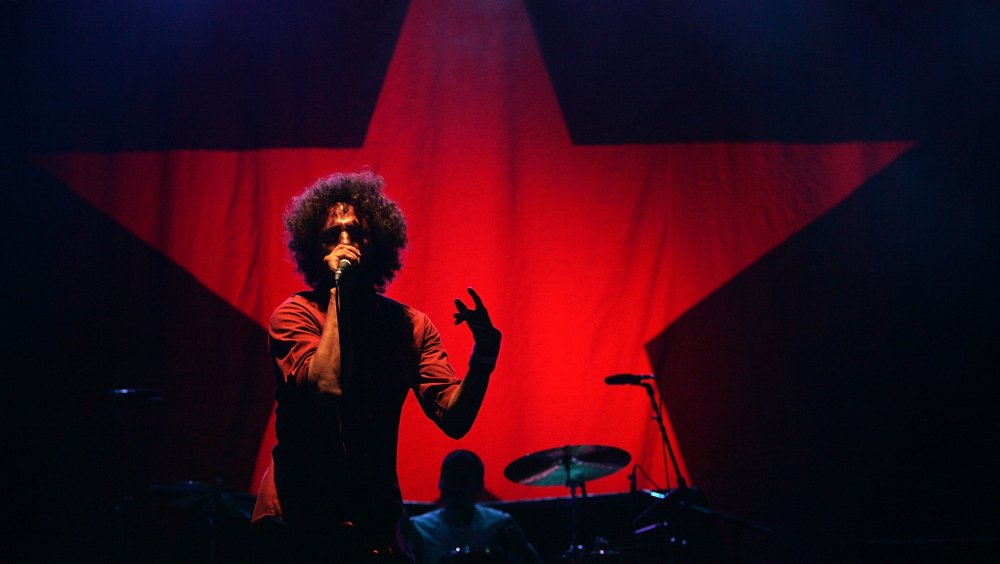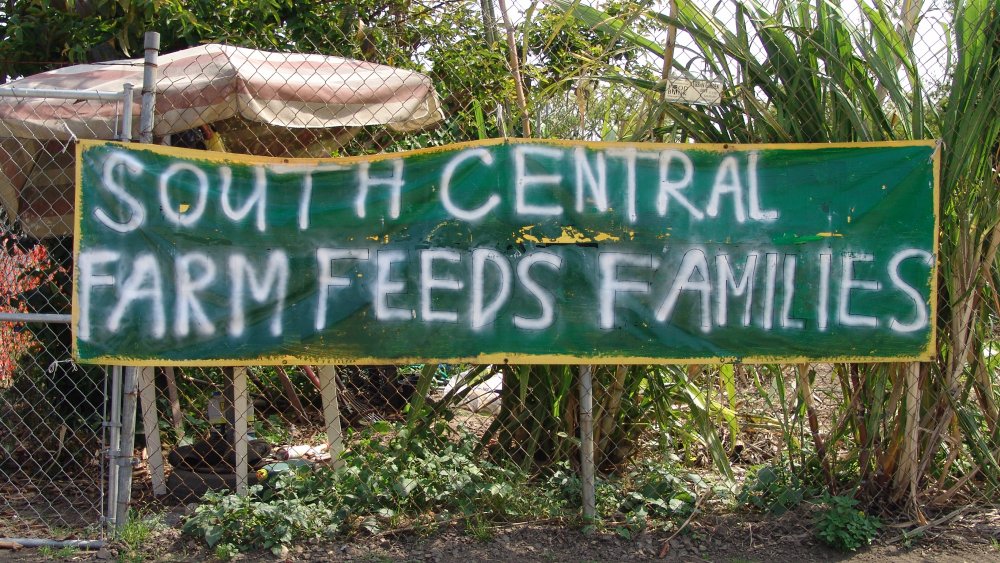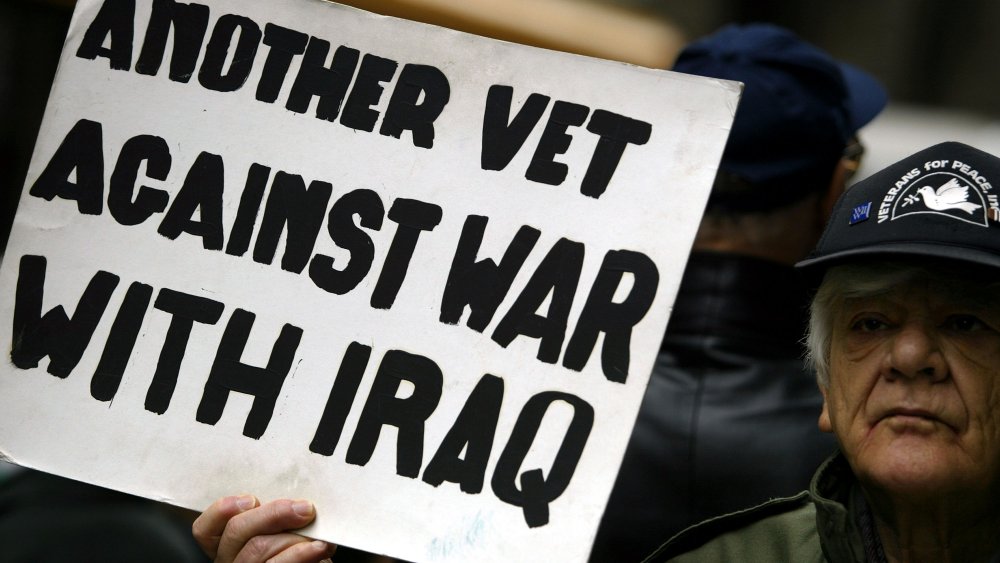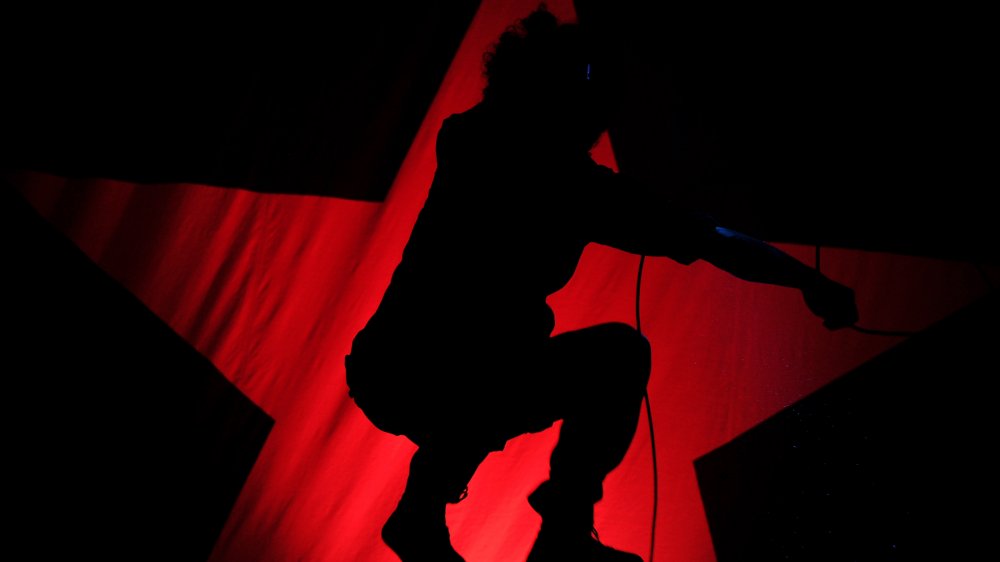The Tragic Real-Life Story Of Rage Against The Machine
Born seemingly from the fire and rage of the 1992 L.A. riots stemming from the Rodney King beating, Rage Against the Machine have led a truly storied career. Vocalist and rapper Zack de la Rocha, guitarist Tom Morello, bassist and backup vocalist Tim Commerford, and drummer Brad Wilk crafted an electrifying and unforgettable brand of politically charged rap-rock that launched them to instant commercial and critical success with their self-titled debut. It's incredibly rare for any commercially successful artist to be able to remain true to their political ideals, but RATM somehow managed to walk that incredibly thin tightrope with each new album until their breakup in 2000.
It's not surprising that a band with controversial political views would encounter strife and challenges during their career. In fact, the personal tragedies and struggles of the band members had a heavy hand in directing their ideals. It's because of the long, hard road to finding their voices that songs like "Killing in the Name" and "Bulls on Parade" still resonate today.
Zack de la Rocha experienced racism early on
Zack de la Rocha was born on January 12, 1970, in Long Beach, California. His father, Roberto "Beto" de la Rocha, was a muralist whose politically charged Chicano artworks with Los Four introduced the radical art style to the area. According to the L.A. Times, the elder de la Rocha was part of a landmark Chicano art exhibition in the mid-'70s, but shortly afterward, he destroyed all his paintings and retreated from the art world for 20 years. The powerful messaging of these works was an early influence on Zack, one which would later be reflected in the socially aware and righteously angry music he'd write — with Rage Against the Machine, in collaborations with other artists, and solo.
De la Rocha's parents divorced when he was still a baby, and he was raised by his mother, Olivia Lorryne Carter, in the city of Irvine in Orange County. There, in an overwhelmingly white area, Zack experienced racism and bullying for his Mexican heritage. One particular incident in high school, during which a teacher casually used an anti-Latino racial slur to de la Rocha's classmates' amusement, reinforced for him the insidious nature of racism, as noted in Rage Against the Machine: Stage Fighters. According to the book Know Your Enemy, de la Rocha called Irvine "one of the most racist cities imaginable."
Tom Morello also experienced racism and political awakening early on
Born in 1964 to a Kenyan revolutionary father and a white American activist mother, Tom Morello is known the world over as one of the great modern American rock guitarists. But it took a difficult upbringing to get him there. Like Zack de la Rocha, Morello's parents divorced when he was just one year old. Also like de la Rocha, Morello experienced racism and bullying, in his case living in a 99.9-percent white town with his mother. According to Know Your Enemy, Mary Morello continued to devote herself to anti-racist and social justice causes, even as hostility toward her mixed-race family made it difficult for them to find housing. Both mother and son were harassed, with Mary sometimes finding Ku Klux Klan paraphernalia in her office, as noted in Stage Fighters. Once, she found a noose hung in their garage.
Growing up, Morello was influenced as much by his personal experiences with racism as by the radical political ideas first introduced by his parents. The Black Panther Party was a regular topic of discussion during Morello's childhood, and he was drawn to the writings of its founders, Huey P. Newton and Bobby Seale. Unsurprisingly, music also heavily influenced his worldview, particularly bands like The Clash, who were using high-octane punk music to deliver criticism of U.S. foreign policy, economic injustice, and other radical messages that would later appear in Morello's music as well.
Tim Commerford lost his mother at a tragically young age
Bassist and backup vocalist Tim Commerford was born in Irvine, California, in 1968, the youngest of five children. His father was an aerospace engineer, and his mother was a teacher and mathematician. In an early, devastating blow, Commerford's mother was diagnosed with brain cancer when he was just seven years old, according to Stage Fighters. By the time Commerford was in third grade, his mother could no longer help with or even understand his homework. She left to get treatment and stay with her sister in Sacramento, while Commerford's father remarried.
Commerford had a difficult relationship with his family, particularly his father. He sometimes lashed out at or bullied other children, as noted in Know Your Enemy. Thankfully, he developed a friendship with Zack de la Rocha in high school. (The two had met in fifth grade). It was Zack who introduced Tim to the bass guitar and inspired him to find healthier outlets in poetry and music.
Tom Morello struggled to find work after college
Even though his upbringing was marked with serious challenges, Morello excelled in school. According to Huffington Post, he was the first student from his high school to attend Harvard. After graduating in 1986 with a Bachelor of Arts in social studies, he moved to Los Angeles, where even a history of hardship and a degree from an Ivy League school couldn't guarantee him work. In Know Your Enemy, Morello is described as being essentially unemployable — too disillusioned by corporate America to find the jobs he was qualified for and too overqualified for the jobs he actually wanted.
With music already a driving goal of Morello's, he searched for daytime and part-time gigs that could support him without getting in the way of his music. In addition to odd jobs and menial labor, Morello took up exotic dancing to pay the bills. According to Exclaim, he worked as a stripper for a period of time, and the Commodores' "Brick House" was his jam. From there, he went to work for California senator Alan Cranston, an experience which furthered his disillusionment with the American political process.
Rage Against the Machine was banned from Saturday Night Live
Right from the start, Rage Against the Machine wrote music that was loudly and fiercely opposed to American systems of power. Songs like "Bulls on Parade," with its searing takedown of the military-industrial complex, and "Killing in the Name," which pulls no punches in the assertion that "some of those that work forces / are the same that burn crosses," were launched onto the charts and into radio — controversial messaging and all. Still, all the popularity in the world couldn't stop Rage Against the Machine from being censored regularly.
One of the most infamous early examples of this was their first, and only, performance on Saturday Night Live in April 1996. According to Rolling Stone, the band's two-song performance was cut down to one after they attempted to hang upside-down American flags on the amps during the set. With billionaire and then-Republican primary candidate Steve Forbes hosting the show that night, RATM saw the perfect opportunity to voice their opposition. Instead, they were essentially chased from the studio and banned from performing on Saturday Night Live ever again.
Police often disrupted Rage Against the Machine's shows
As with their history of censorship, Rage Against the Machine has a long and storied tradition of having their shows disrupted or shut down by police. According to The Seattle Times, Sheriff Bill Wiester attempted (and ultimately failed) to block the band from performing a concert at the Gorge, claiming that RATM's presence would lead to disorderly behavior. A performance and demonstration at the 2000 Democratic National Convention led to a crowd of about 8,000 getting chased out and beaten with batons by mounted police and fired on with rubber bullets, according to Salon. At least six people were arrested, an action which was condemned by the American Civil Liberties Union.
Perhaps most notable was the New York Stock Exchange incident. According to Rage Against the Machine, the band was in front of the building, filming a music video for "Sleep Now in the Fire," helmed by documentary filmmaker Michael Moore. Police eventually arrived and ordered the makeshift concert shut down, detaining and removing Moore. Rage Against the Machine, along with members of the crowd, attempted to enter the building, and in an incredibly rare occurrence, the NYSE's security doors slammed shut, and the entire exchange closed an hour early.
Zack de la Rocha's departure from Rage Against the Machine was painful
By 2000, the pressure on Rage Against the Machine was building to a breaking point. Between pleasing their hungry fans, satiating their music industry handlers, and avoiding police violence and national censorship here and there, it's a wonder that the band didn't break up earlier. In October 2000, Zack de la Rocha pulled the trigger and announced that he was leaving RATM. According to E! Online, de la Rocha felt the band's decision-making process wasn't working and was undermining their "artistic and political ideal." But the decision was very difficult, and it took a heavy toll on de la Rocha.
The rest of Rage Against the Machine, meanwhile, wasn't interested in breaking up. Commerford, Wilk, and Morello issued a statement following the one from de la Rocha, saying that they were committed to effecting political and social change as well as continuing to write groundbreaking music. In their search for a new lead singer, the band found Chris Cornell of Soundgarden and formed Audioslave in 2001. That band, too, would reach critical and commercial success, although their music was notably not political. Audioslave released three albums before breaking up in 2007, according to Loudwire. Shortly after a reunion in 2017, Cornell took his own life.
Zack de la Rocha was creatively restless
After leaving Rage Against the Machine, Zack de la Rocha continued to be a prolific songwriter and collaborator. According to NPR, he formed a short-lived duo called One Day as a Lion with Jon Theodore of The Mars Volta, appeared in Run the Jewels songs, and worked on solo music produced by El-P, Saul Williams, DJ Shadow, and more. Some of de la Rocha's unreleased material from these collaborations is the stuff of legend. According to MTV, there are almost two whole albums' worth of music from an early 2000s partnership between de la Rocha and Trent Reznor that has yet to see the light of day. De la Rocha was creatively restless and frequently unsatisfied, often remaining elusive for long stretches of time following his departure from RATM.
De la Rocha would go on to reunite with his Rage Against the Machine bandmates at Coachella in 2007 and played around 50 shows with them over the next four years, but he continued to go his own way. According to Rolling Stone, he was strangely absent during the highly charged 2016 election year, even as his former bandmates got together to form yet another band. This time, the three joined forces with members of Public Enemy and Cypress Hill to form Prophets of Rage.
Rage Against the Machine's message was censored and often misunderstood
Following the terrorist attacks on September 11, 2001, Clear Channel released a memo with a long list of music that was considered "lyrically questionable" for the radio. According to The Austin Chronicle, every one of Rage Against the Machine's songs were listed.
In 2007, RATM shook the music world with their first reunion performance at Coachella. According to MTV, Zack de la Rocha wasn't vocal between songs, until it came time to discuss the Bush administration. In a passionate aside during "Wake Up," the singer proclaimed, "Our current administration needs to be tried, hung, and shot. We need to treat them like the war criminals they are." This, of course led, to backlash, which was further twisted into a national-scale rage by Fox News, who claimed that the band wanted the president assassinated, as noted by NME.
From de la Rocha's perspective, this wasn't true: He differentiated between being tried for war crimes and being assassinated, but considering his and his band's history of bold and controversial statements in direct opposition to the country's systems of power, it's no surprise that nuance was missed.
The South Central Farm protests were ultimately unsuccessful
One thing that has always set Rage Against the Machine apart from other bands is their commitment to their ideals both on and off the stage. Both Zack de la Rocha and Tom Morello became involved in efforts to save the South Central Farm in Los Angeles, according to Rolling Stone. From 1994 to 2006, the farm and community garden provided food and education to a historically underserved area of L.A. After a developer planned to bulldoze the farm, high-profile activists and musicians like Willie Nelson, Joan Baez, and Julia "Butterfly" Hill came together to lead efforts to save it.
In 2006, de la Rocha and yet another of his musical projects, son jarocho (a folk style from Veracruz, Mexico) band Son de Madera, put on a benefit show at the Natural History Museum of Los Angeles County, according to SPIN. The performance drew a crowd that spanned three city blocks, all rallying to support the majority-Latino farmers who had been cultivating food in the harsh warehouse district. But property value eventually won out. The community was evicted, and the farm was bulldozed.
2008: reunion and protests
If conservatives were hoping the 2007 Coachella outrage would keep Rage Against the Machine off the airwaves, they were sorely mistaken. In fact, although that performance was intended to be a one-off, the band went in the opposite direction. In 2008, they performed huge concerts coinciding with both the Republican and Democratic National Conventions. According to the Star Tribune, their massive show in Minneapolis during the RNC was flanked with police in full riot gear. The band took the stage in Guantanamo Bay-esque orange jumpsuits and black hoods. Accounts vary, but between 70 and 100 people were arrested after the performance when fighting broke out between the police and the crowd.
According to the L.A. Times, the band's twin performance during the Democratic National Convention in Denver that year was no less controversial. This time, the show was followed by an anti-war protest led by about 50 veterans of the Iraq war. Marchers said they wanted to hold Barack Obama to his promise of ending the war. After they finished playing, RATM led more than 4,000 audience members behind the vets on a four-mile march to the convention, leading to a tense five-hour standoff with the police.
Rage Against the Machine was due for another big reunion in 2020
Rage Against the Machine were set to reunite once again and headline 2020's Coachella festival. As the coronavirus pandemic began to rapidly worsen, the spring event was postponed to October, according to Billboard. It was then cancelled outright, with tentative plans to resume holding the desert arts and music festival in 2021. But as of this writing, there is no lineup information available, and even 2021 is starting to sound like an extremely optimistic time frame for being able to resume live shows. It's anybody's guess whether RATM will play the festival in 2021, just as it's anybody's guess whether or not the festival will happen.
Rage Against the Machine's own planned reunion tour was also canceled in the wake of the pandemic, which, in many ways, is a tragedy in itself. As noted by Kerrang, critics have always sneered at RATM's ongoing struggle to use music to institute real social change. But the band never stopped backing up their ideals and their art with real-world action, no matter what tragedies and challenges they were thrown against.
